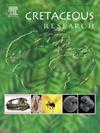Sea-level and paleoenvironmental changes revealed by benthic foraminifera across Oceanic Anoxic Event 2 (OAE 2) at Eastbourne (SE England)
IF 1.7
3区 地球科学
Q1 GEOLOGY
引用次数: 0
Abstract
The Cenomanian–Turonian Oceanic Anoxic Event 2 (OAE 2) severely disrupted the global carbon cycle with widespread deposition of organic-rich marine sediments, resulting in a positive carbon isotope excursion. The Eastbourne section in southeastern England offers extensive benthic and planktonic foraminiferal data, revealing four distinct paleoenvironmental intervals across OAE 2.
The Grey Chalk interval below OAE 2, which is characterized by the highest species diversity of benthic foraminifera, represents outer neritic-upper bathyal paleodepths, oxygenated environments and low organic fluxes at the seafloor. Deep- and thermocline-dwelling planktonic foraminifera suggest meso-oligotrophic regimes with a well-stratified water column.
The onset of OAE 2 in Bed 1a of the Plenus Marl is marked by a sea-level fall supported by the maximum peak in abundance of shallow water agglutinated foraminifera (Ataxophragmium depressum, Arenobulimina, Plectina cenomana) and by the disappearance of bathyal taxa (e.g., Tristix excavata, Kalamopsis grzybowsky).
In Bed 1b of the Plenus Marl, corresponding to the onset of the Plenus Cold Event, Eggerellina, Gaudryina, and Textularia replace shallow agglutinated taxa indicating a transgressive phase. This assemblage also coincides with the occurrence of Boreal planktonic foraminifera that suggests the incursion of Boreal waters into the Anglo-Paris Basin.
The White Chalk, in the upper part and the interval above OAE 2, is interpreted as a Transgressive and Highstand Systems Tract with a change in the benthic foraminiferal assemblage towards the dominance of Marssonella, Gavelinella, Lingulogavelinella and Tritaxia with warmer and more mesotrophic waters recorded by the dominance of Tethyan planktonic foraminifera.
英国伊斯特本海洋缺氧事件2 (OAE 2)中底栖有孔虫揭示的海平面和古环境变化
Cenomanian-Turonian Oceanic Anoxic Event 2 (OAE 2)严重破坏了全球碳循环,富有机质海洋沉积物广泛沉积,导致碳同位素正偏移。英格兰东南部的伊斯特本剖面提供了广泛的底栖生物和浮游有孔虫数据,揭示了OAE 2中四个不同的古环境区间。OAE 2以下的灰色白垩层段是底栖有孔虫物种多样性最高的层段,代表了浅海-上深海古深度、含氧环境和海底低有机通量。生活在深海和温坡的浮游有孔虫表明具有分层良好的水柱的中贫营养状态。在Plenus marle 1a层,OAE 2的发生以海平面下降为标志,而海平面下降是由浅水聚集有孔虫(Ataxophragmium洼地,Arenobulimina, Plectina cenomana)丰度的最大峰值支撑的,而深海分类群(如Tristix excavata, Kalamopsis grzybowsky)的消失为标志。在正珥海泥沼1b层,与正珥冷事件的发生相对应,Eggerellina、Gaudryina和texularia取代了浅层凝集类群,显示了海侵期。这种组合也与北方浮游有孔虫的出现相吻合,这表明北方水域侵入了盎格鲁-巴黎盆地。在OAE 2的上部和以上区间,White Chalk被解释为海侵和高水位系统域,底栖有孔虫组合向Marssonella、Gavelinella、Lingulogavelinella和Tritaxia为主变化,并且以特提斯浮游有孔虫为主,记录了更温暖和更多的中营养化水域。
本文章由计算机程序翻译,如有差异,请以英文原文为准。
求助全文
约1分钟内获得全文
求助全文
来源期刊

Cretaceous Research
地学-地质学
CiteScore
4.10
自引率
19.00%
发文量
235
审稿时长
12 weeks
期刊介绍:
Cretaceous Research provides a forum for the rapid publication of research on all aspects of the Cretaceous Period, including its boundaries with the Jurassic and Palaeogene. Authoritative papers reporting detailed investigations of Cretaceous stratigraphy and palaeontology, studies of regional geology, and reviews of recently published books are complemented by short communications of significant new findings.
Papers submitted to Cretaceous Research should place the research in a broad context, with emphasis placed towards our better understanding of the Cretaceous, that are therefore of interest to the diverse, international readership of the journal. Full length papers that focus solely on a local theme or area will not be accepted for publication; authors of short communications are encouraged to discuss how their findings are of relevance to the Cretaceous on a broad scale.
Research Areas include:
• Regional geology
• Stratigraphy and palaeontology
• Palaeobiology
• Palaeobiogeography
• Palaeoceanography
• Palaeoclimatology
• Evolutionary Palaeoecology
• Geochronology
• Global events.
 求助内容:
求助内容: 应助结果提醒方式:
应助结果提醒方式:


